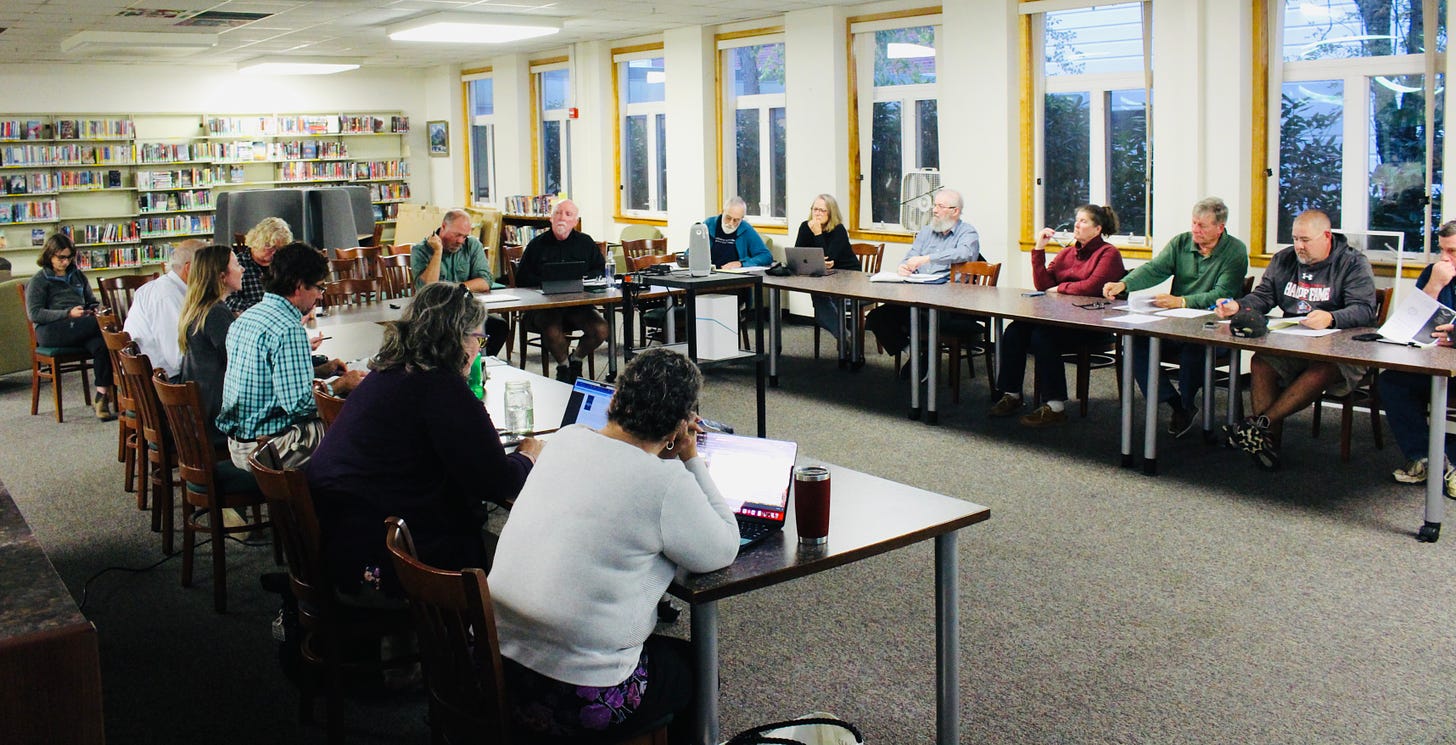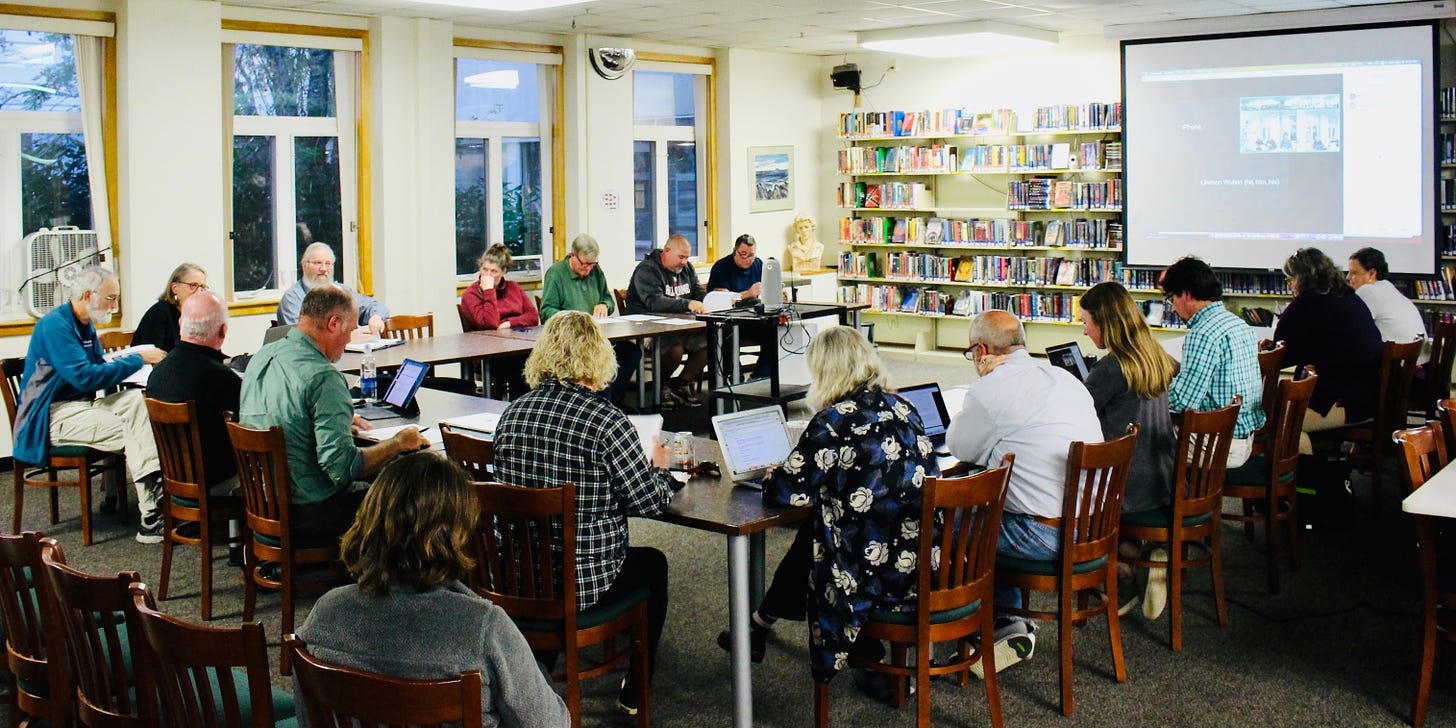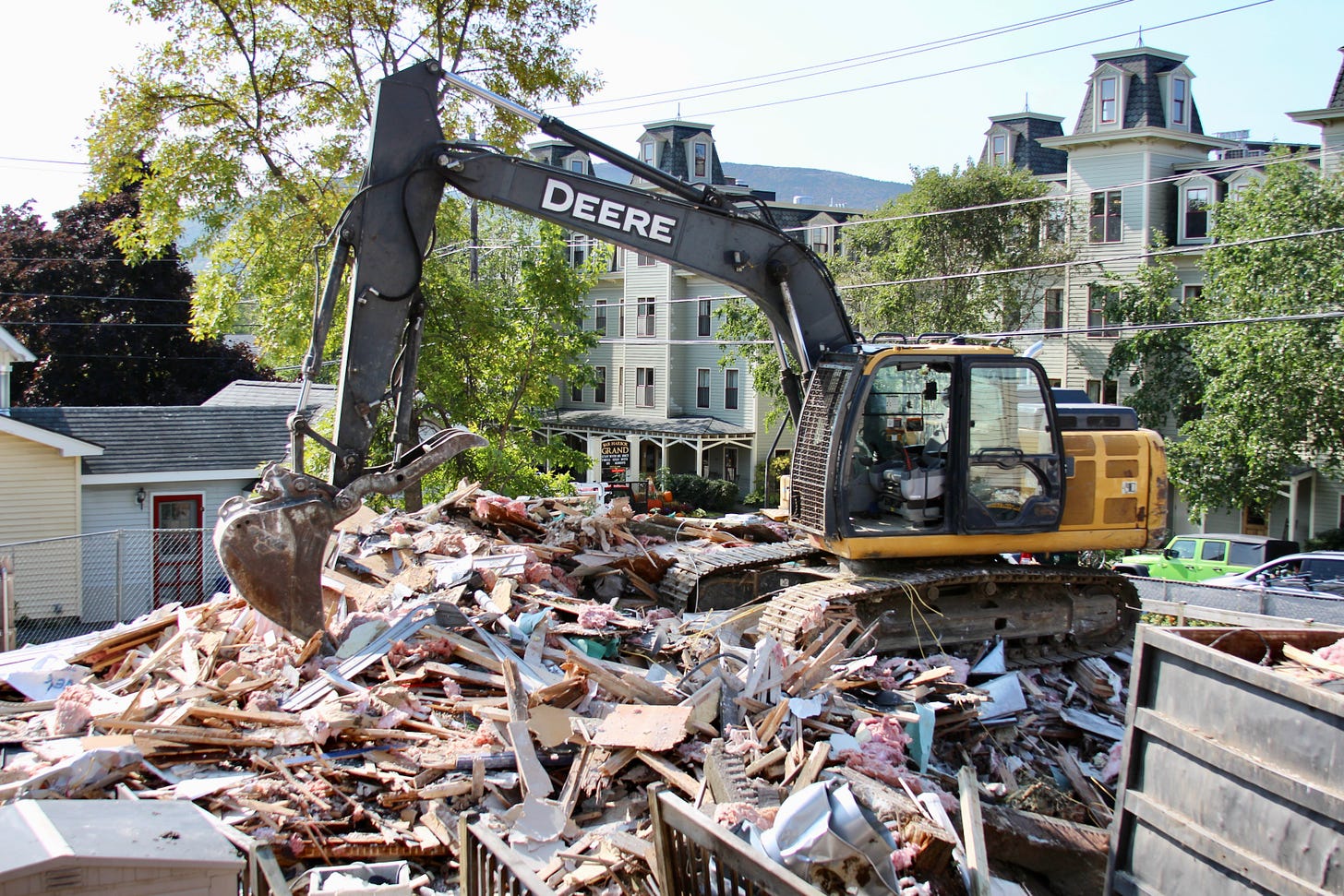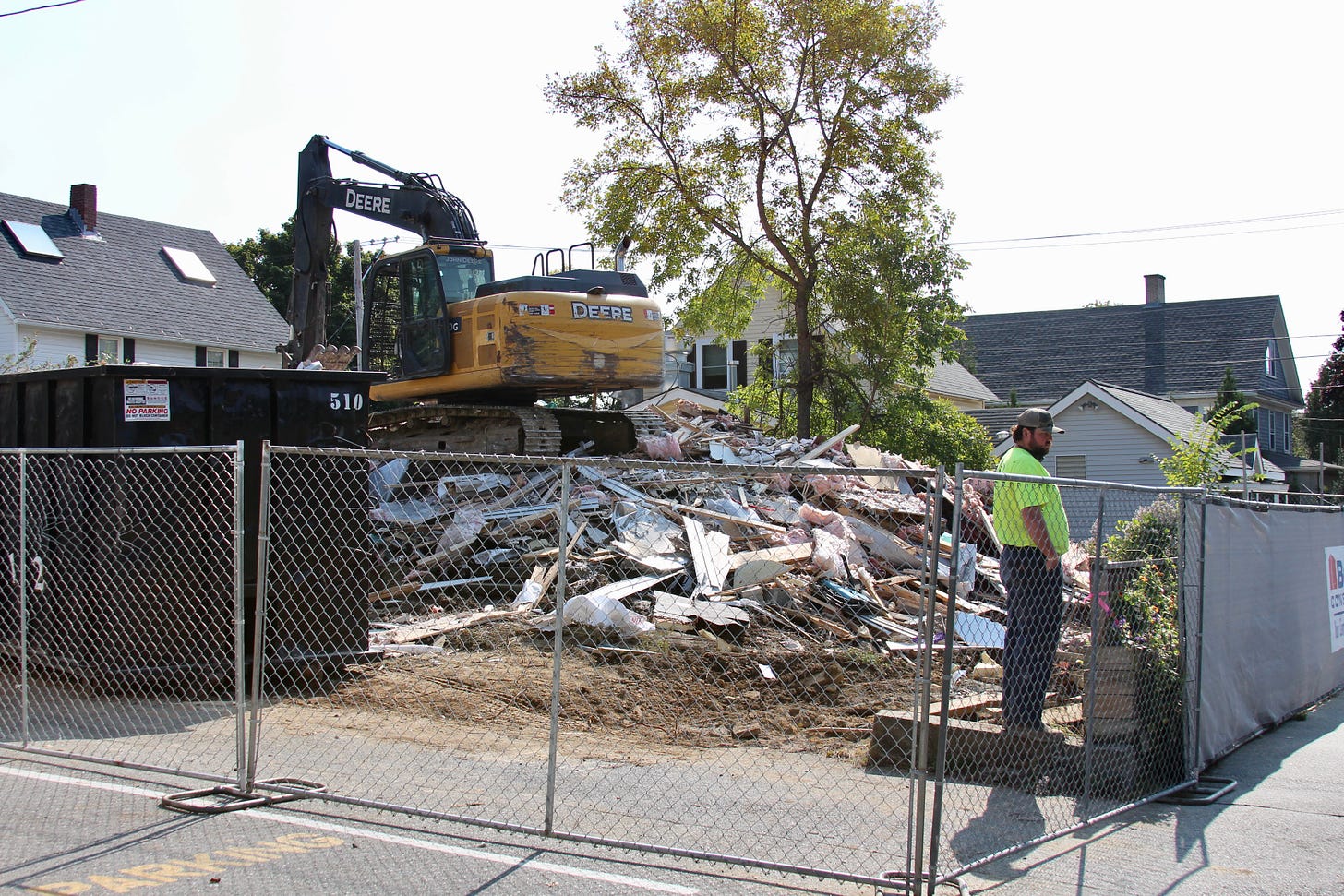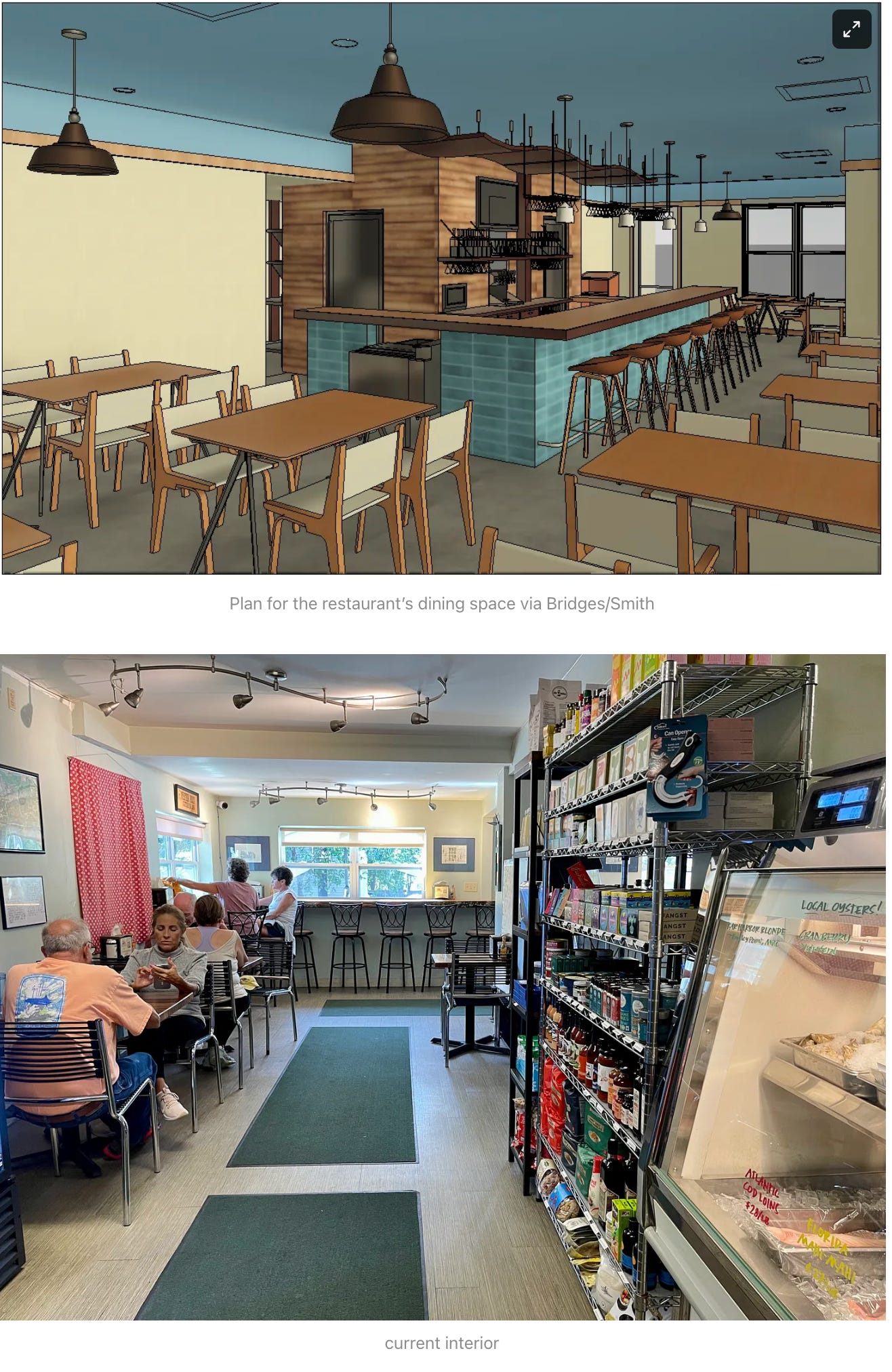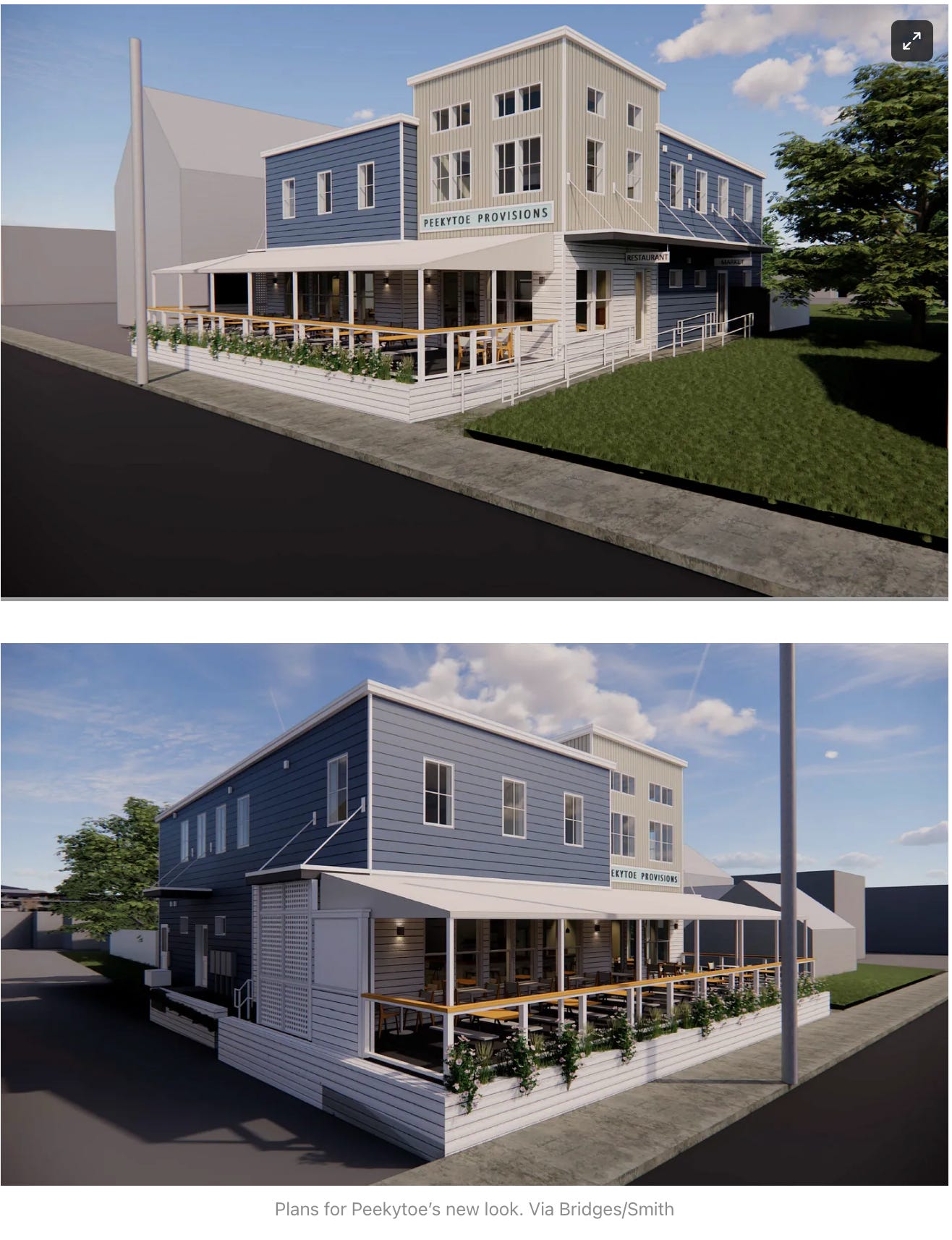Multi-Million Dollar High School Bond Would Have to Be a Multi-Town Referendum Vote
PeekyToe Building Comes Down
BAR HARBOR––What happens when a school defaults on a bond? At Monday night’s meeting of the MDI Regional High School Board of Trustees those gathered learned it could be something scary.
The trustees sailed smoothly through the normal agenda items. There was no public comment and the approval of the agenda and the minutes of the prior meeting were both unanimous.
The first substantial agenda item was a talk with William Stockmeyer of the Portland law firm, Drummond and Woodsum, regarding the intricacies of a bond issuance for the High School building project.
WHY MOST BONDS NEED VOTER APPROVAL
The ultimate question being answered by Stockmeyer was whether or not the Board of Trustees has the authority to issue bonds without it going to a referendum vote.
Stockmeyer started off by saying that the project was initially conceived as a renovation project and that a Community School District (CSD) Board of Trustees has the authority to issue bonds under private law for renovation projects but not construction projects. Stockmeyer also said the assumption is that the MDI Regional High School is a CSD and that it is referenced as such by the Maine Department of Education.
However, the founding documents that establish the school district make no mention of it being a CSD and that it technically could be questioned if it is indeed one. A copy of the enabling legislation from 1963 can be found here. A copy of the interl-ocal agreement creating the Mount Desert island Regional School System in 2008 can be found here.
Trustee Deidre Rigby asked if they are not a CSD, what were they. Stockmeyer said that the MDI School District was created under private law. He said that he was not saying that the district isn’t a CSD; he was just saying that there is some doubt.
There was much more discussion regarding statutes and laws governing a Board of Trustees issuing bonds without a referendum vote, but in the end, none of it mattered for a few reasons. The project doesn’t meet the renovation threshold and it’s unlikely that it would receive the necessary approval without going to referendum. The current economic environment is also not favorable. It would have to be a bond.
Stockmeyer said interest rates have doubled lately and construction costs have also sharply risen. He gave examples of a few school districts in Maine, including Cape Elizabeth, Scarborough, and SAD 51. These districts, he said, have been historically very supportive of their school districts, but are not passing school projects lately that were going to be locally funded.
He explained how bonds that a school district issue do not utilize the property of the school district as collateral, but rather, the properties of the taxpayers. In the extremely unlikely event of a bond default, it would be the taxpayers’ real property, their private homes, that would be sold to pay off the bonds.
This is why it is generally necessary to get voter approval for bond issuances.
THE ROLE OF BOND COUNSEL
Stockmeyer said that courts generally hold that they require strict adherence to all statutory requirements for issuing bonds. If all the requirements are not satisfied, a court may rule that the public officials may have exceeded their authority and find that the fault lies with the bond issuers, the lenders, and invalidate the bond. For this reason, nobody would buy the bonds.
No bond holder could reasonably be expected to understand all of the laws that apply to any particular government entity. For this reason, the bond community requires not only the bond, which is essentially the promissory note, but also that the entity’s bond counsel, in this case Drummond and Woodsum, give a legal opinion to the bond holders that the bond is valid and enforceable. This opinion must be an independent opinion and must meet a high standard of assurance. Nobody would purchase a bond without this seal of approval, Stockmeyer said.
So, while a Board of Trustees may issue bonds for certain projects, Drummond and Woodsum would not give its approval of the bond issuance without it going before the voters for approval.
In the highly unlikely event of a default, the bond holders could proceed against each town for the full amount of the bond and that Maine has a statute that allows them to do so, Stockmeyer said. This is why the warrant has to be very clear on the amount of the bond issuance and the breakdown should be addressed by other avenues of public notification.
IS THE PROJECT RENOVATION OR CONSTRUCTION?
Trustee Tony Smith said that he thought this was considered a renovation project.
Stockmeyer said that part of the plan contains the addition of a new stairwell and classroom and that the difference between a renovation and a construction project is that a renovation is something like a new roof, new asphalt for a parking lot, or a new HVAC system. Anything that has an addition of over 600 square feet is a construction project, which automatically requires voter approval of a bond issuance.
HOW A REFERENDUM VOTE WOULD WORK
Board Chair Rob Jordan said that he didn’t think that any of the trustees would want to try and move forward without a referendum vote. He asked what the process would be and if it could be one referendum vote where all four of the island towns vote together.
Stockmeyer said that he would expect all of the four towns on the island to vote on the same day and that it would be best if all four towns had the same polling hours unless it was a normally established voting day. Stockmeyer also said that the outcome is based on a majority of yes votes across the district as a whole. Meaning, a small population town could vote as a majority of no votes but if a larger population town voted as a majority of yes votes, this could outnumber the no votes from the smaller town and still make the referendum pass.
Smith then said, just to clarify, that they are talking about four separate votes that are held on the same day for the same hours, one in each of the four towns.
Each town would need to call the referendum item by warrant, which needs to be countersigned by the municipal officers and posted in each town. The warrants would be the same but they would be signed by different municipal officers and call different voters, Stockmeyer said.
There was discussion about letting each town know how much of the total amount of the bond each separate town would be responsible for. Trustee Joe Cough asked if each town would have their own assessment of the total amount based on the formula used to determine how much each town contributes.
Stockmeyer said that he didn’t think that the board needed to have each allocation because each town would be voting on the total amount of the bond and warned about using language that could possibly be seen as swaying the vote.
Cough said that he has never seen a warrant that is broader than the amount of money that the town would actually be paying.
NO ASSISTANCE FROM TUITION AND FULL DISCLOSURE
Trustee Keri Hayes asked if any of the tuition money from the tuition students would impact the total amount of money paid by the four towns.
High School Principal Matt Haney said that they are allowed to charge a 10% debt surcharge on top of the tuition rate for the life of the bond but that money goes into the school’s general fund, so it would not directly affect the payment of the bond.
Trustee Chad Terry asked if each warrant could have a breakdown for each of the four towns’ obligations on it.
Stockmeyer said that the warrant itself could have the breakdown by town, whether it be a percentage or a dollar amount, but that language has to be exact on all four warrants so each warrant would have to include the breakdown of each town. He also said again that he greatly prefers that information be disseminated outside of the warrant and that each voter understands that the obligation falls on the district as a whole.
“The idea of having information available to tax payers, plenty of it, what our current model of funding is, and being able to share that, I am sure that will be in the paper and be out there in plenty of places as you described, Bill. The idea of making sure the bond is pretty simple within the ballot itself and then we have multiple ways of being able to share what that impact will be on taxpayers,” said School Superintendent Mike Zboray.
THE FORMULA THAT DECIDES HOW MUCH EACH OF THE FOUR TOWNS WOULD PAY
Principal Haney said that the formula is a little complex but can be simplified. Basically, “the amount assessed to the four towns is determined by the total cost of the budget minus any other sources of revenue. The primary other sources are state subsidy (usually between $500k and $1 million) and tuition (usually between $1.5 and $2 million).”
The assessed amount for each town is divided up by using a formula that gives a 67% weight to the town’s property valuation and a weight of 33% to the town’s high school student enrollment.
For the 2023-24 school budget year the four towns are paying the following percentages.
Bar Harbor – 37.79%
Mount Desert – 35.6%
Southwest Harbor – 14.29%
Tremont – 12.32%
THE BUILDING PROJECT
A November 30, 2022, article by Dick Broom in the Mount Desert Islander describes the building project as renovations including, “the addition of a second story to the library, reconfiguring the science labs, creating a new main entrance and entrance hall and making associated changes.” According to the article, the estimated cost for the project at that time was between $23.7 million and $26.5 million.
Since that time, the Board of Trustees have altered the plans and greatly reduced the price. In the meeting notes for of the board’s December 19, 2022, meeting, Haney said, he “would hate to see if another town doesn’t get to do something they need to do because of the high school project.”
Ultimately, the Board of Trustees decided to go back to the architect, Oak Point Associates, and see if they could cut the price of the construction project by refurbishing existing rooms and only moving a few walls on the second floor in order to bring the science rooms up to modern standards for safety and learning. They did.
The latest version of the project, according to meeting notes for the board’s January 30, 2023, and February 27, 2023, meetings show the following.
A staircase is relocated and in its former place is a student lounge;
The library spaces have been reconfigured and there are two doors added to the outside courtyard space. Some provision to keep the gravel and outside debris from getting tracked into the library;
A classroom within the library has been added. One wall of the classroom could be moved aside to create a larger meeting space;
There is new construction in the main entrance and stairwell;
There is improved safety and security;
There is a new space for social gathering for students and breakout areas for project rooms;
The nurse’s area is more appropriately sized and will have an exit to an exit corridor space;
Science labs will be revised to meet today’s standards for science and safety;
New ceilings and heating, venting, and air conditioning (HVAC) will be installed as well as light fixtures throughout;
Air conditioning and heat circulation will also be addressed in other parts of the building project. It does not include the art wing, cafeteria, auditorium, and classrooms along that hallway.
After all of the adjustments to the construction plan, the new total is estimated to be $15,914,155 which is a reduction of $8 - $10 million.
PEEKYTOE COMES DOWN
The Peektoe Provisions building came down September 17 as part of its new building project discussed in an earlier article that is linked below.
The present building was built in 1890 and has had several additions put on since then. Starting fresh and designing for efficiency and sustainability outweighed the potential problems of an old building requiring more fixing every few years and who knows what else over time,” co-owner Cyndi Bridges said.
The new building will allows them to separate the market side from the restaurant side of the business, triple the size of the kitchen, triple the amount of indoor seating, add a full bar, cover the outdoor seating so it is not weather dependent, and add three apartments upstairs to accommodate for year round housing for year round employees.
LINKS TO LEARN MORE
https://peekytoeprovisions.com/






